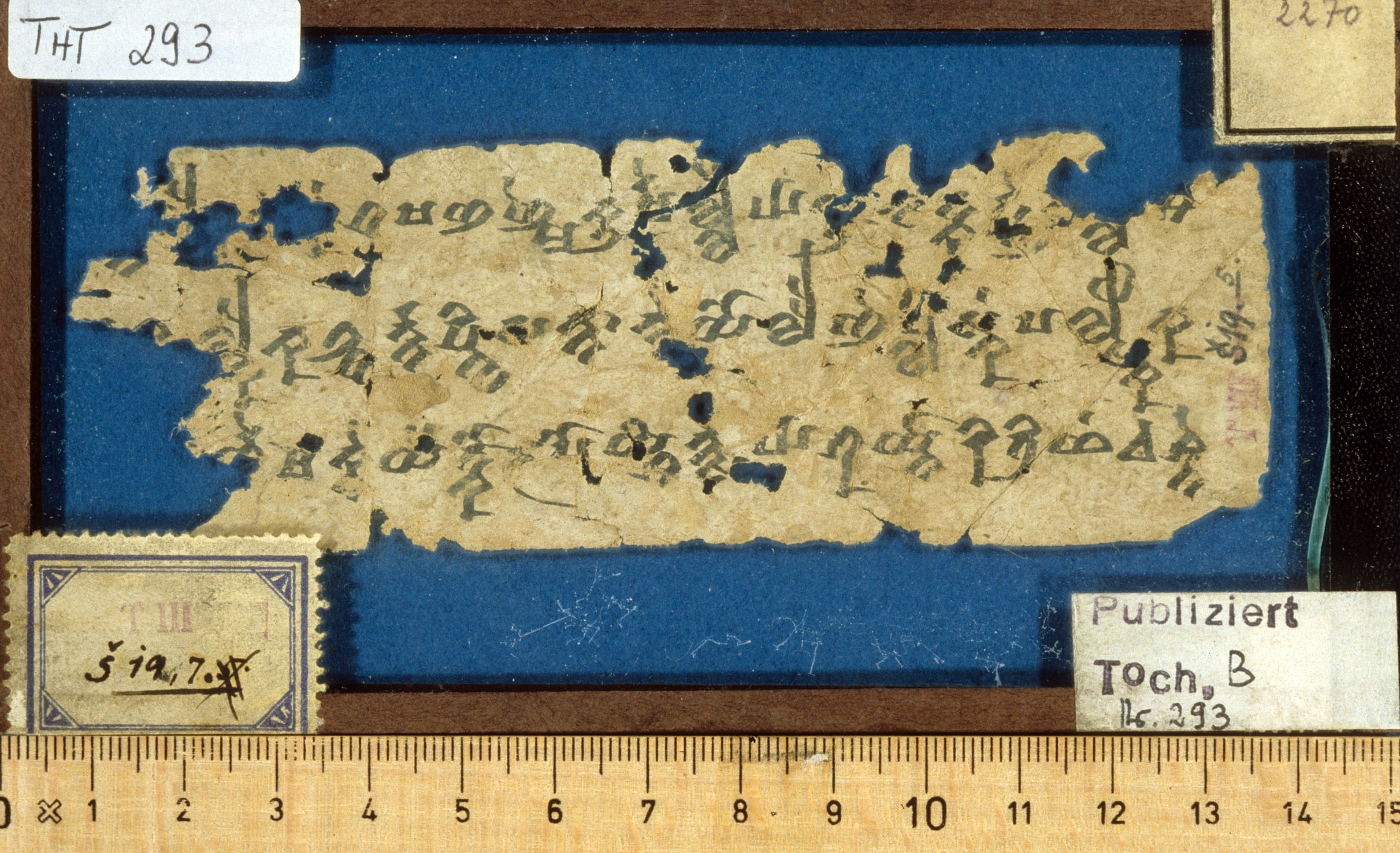THT 293
| Known as: | THT 293; B 293; Bleistiftnummer 2270 |
|---|---|
| Cite this page as: | Adrian Musitz (translation). "THT 293". In A Comprehensive Edition of Tocharian Manuscripts (CEToM). Created and maintained by Melanie Malzahn, Martin Braun, Hannes A. Fellner, and Bernhard Koller. https://cetom.univie.ac.at/?m-tht293 (accessed 12 Jul. 2025). |
Edition | |
| Editor: | Adrian Musitz (translation) |
Provenience | |
| Main find spot: | Shorchuk |
| Expedition code: | T III Š 19.7 (on the frame), T III Š 19.5 (on the fragment) |
| Collection: | Berlin Turfan Collection |
Language and Script | |
| Language: | TB |
| Linguistic stage: | classical |
| Script: | classical |
Text contents | |
| Text genre: | Literary |
| Text subgenre: | Kāvya |
| Verse/Prose: | verse |
| Meter: | 4343 (4x) |
Object | |
| Material: | ink on paper |
| Form: | Poṭhī |
| Number of lines: | 3 |
Images
Images from idp.bl.uk by courtesy of the International Dunhuang Project, the Berlin-Brandenburgische Akademie der Wissenschaften, and the Staatsbibliothek zu Berlin – Orientabteilung.
Transliteration
| a1 | /// ·n· l·e – ·[e][¯] [¯]t ṣa ña ñme ku r[p]e lle 10 [6] [ai] tk[a] tñe – ·l· ś· |
|---|---|
| a2 | /// lke ka lta rnta cwi sa ntā ne yo lai ñe [p]lā skaṃ pa lsko ka |
| a3 | /// r[ñ]e ma kte y[ai] tko¯ ¯r po yśi ntse 10 7 ytā ri tri śaṃ e śne |
| b1 | /// e śne sa me ṅki tse – tkā ra ·rī śaṃ ai śau mye ce¯ ¯u na kse |
| b2 | /// [y]kā¯ ¯k cai nrai ne tsa ksa ntra : – 8 so l[m]e pai yn[e] kl· ya |
| b3 | /// ·ā pai yne sa me ṅki tse stm[au] sa va ṣ(·)i [pai] yn· – t[k]ā [ra] trā |
Transcription
| 16d | /// ·n· l·e – (k)et ṣañ-añme ; kurpelle 10-6 |
|---|---|
| 17a | aitkatñe – ; ·l· ś· a2 11σ |
| 17b | /// (mā) (ṣpä) (wa)lke ; kaltär nta ; cwi santāne ; yolaiñe |
| 17c | plāskaṃ palsko ; ka a3 9σ |
| 17d | 6σ /// rñe ; mäkte yaitkor ; poyśintse 10-7 |
| 18a | ytāri triśäṃ ; eśne b1 8σ |
| 18b | 7σ /// ; eśnesa meṅ;kitse – |
| 18c | tkā ra (t)rīśäṃ ; aiśaumye ; ceu nakse b2 4σ |
| 18d | 7σ /// ; ykā-k cai nraine ; tsäksanträ : (10-)8 |
| 19a | solme paiyne ; kl(ā)ya b3 8σ |
| 19b | 7σ /// ; (m)ā paiynesa ; meṅkitse |
| 19c | stmau savaṣ·i ; paiyn(esa) ; tkā ra trā 4σ |
Translation
| a1 | ... who has to be concerned about himself... |
|---|---|
| a1+ | ... unordered (?)... |
| a2 | ... and not for long remains evil in his birth-cycle. |
| a2+ | ... if he thinks a... thought... |
| a3 | ... as the command of the Buddha. |
| a3+ | If he mistakes the way... eyes... |
| b1 | ... lacking eyes... |
| b1+ | Then, if the wise man errs, (they) reproach him.... |
| b2 | ... they are still burned in hell. |
| b2+ | ... whole... feet... fell... |
| b3 | ... not lacking feet... Having stood... on feet... then... |
Other
| b2 | ... noch brennen sie in der Hölle. (Schmidt 1974: 133) |
|---|
References
Online access
Edition
Translations
Hackstein 1995: b2 (90); Schmidt 1974: b2 (133)
Bibliography
Hackstein, Olav. 1995. Untersuchungen zu den sigmatischen Präsensstammbildungen des Tocharischen. HS Erg.-Heft 38. Göttingen: Vandenhoeck & Ruprecht.
“The International Dunhuang Project: The Silk Road Online.” n.d. http://idp.bl.uk.
Schmidt, Klaus T. 1974. “Die Gebrauchsweisen des Mediums im Tocharischen.” PhD, Universität Göttingen.
Sieg, Emil, and Wilhelm Siegling. 1953. Tocharische Sprachreste. Sprache B, Heft 2. Fragmente Nr. 71-633. Edited by Werner Thomas. Göttingen: Vandenhoeck & Ruprecht.
Gippert, Jost, Katharina Kupfer, Christiane Schaefer, and Tatsushi Tamai. n.d. “Thesaurus Indogermanischer Text- und Sprachmaterialien (TITUS): Tocharian Manuscripts from the Berlin Turfan Collection.” http://titus.fkidg1.uni-frankfurt.de/texte/tocharic/thtframe.htm.




